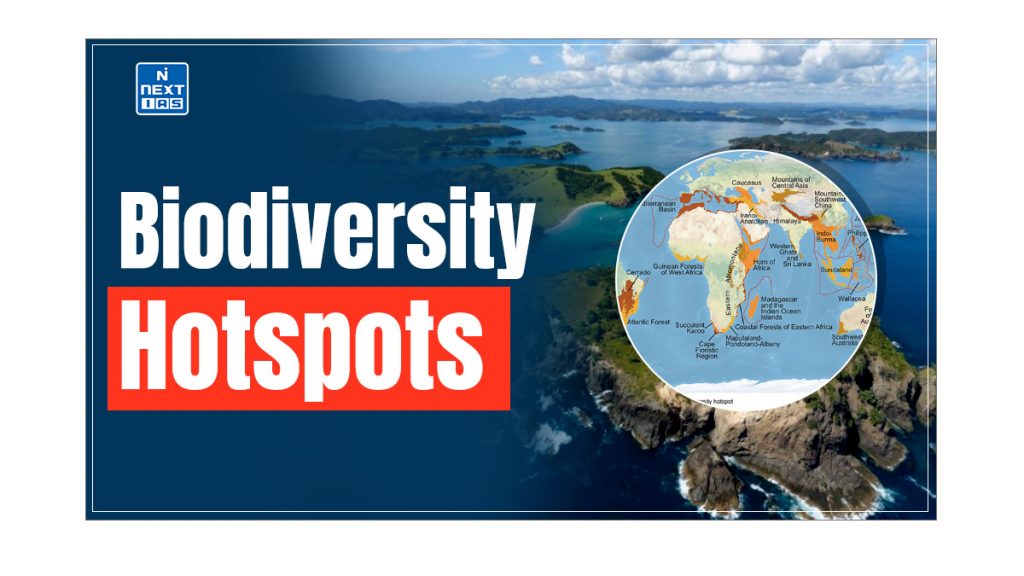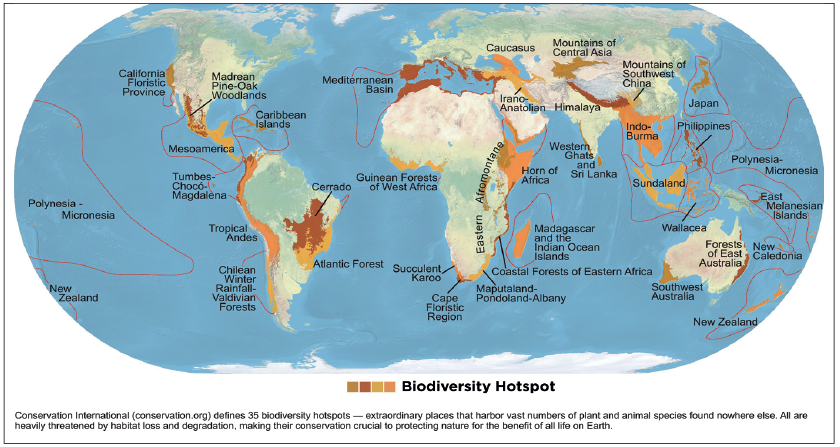
Biodiversity Hotspots, or Biological Diversity Hotspots, are invaluable reservoirs of life on Earth, representing regions of immense ecological, genetic, and cultural importance. Their conservation is crucial for maintaining global biodiversity and ensuring the sustainability of ecosystem services that humanity relies on. This article aims to study in detail the concept of Biodiversity Hotspots (Biological Diversity Hotspots), its meaning, criteria, and the list of hotspots in India and the world.
What is Biodiversity Hotspot?
- Biodiversity Hotspots refer to biogeographic regions that are both a significant reservoir of biodiversity and are threatened with destruction.
- In other words, they are regions that are both rich in biodiversity and significantly threatened by human activities.
- These areas are critical for conservation efforts due to their high levels of endemic species, which are species found nowhere else on Earth.
Evolution of Concept of Biodiversity Hostspots
- 1988: Biodiversity Hotspot as an idea was first developed by Norman Myers in 1988.
- 1989: Conservation International (CI) adopted Myers’ hotspots as its institutional blueprint in 1989.
- 1999: In 1999, Conservation International (CI) carried out a thorough global assessment that established quantitative criteria for designating hotspots of biological diversity.
Criteria for Qualification as Biodiversity Hotspots
To qualify as a biodiversity hotspot, a region must fulfil the following two strict criteria:
- Endemism: It must have at least 1,500 vascular plants as endemics (> 0.5% of the world’s total) — i.e. it must have a high percentage of plant species found nowhere else on the planet
- A hotspot, in other words, is irreplaceable.
- Threat Level: It must have lost 70% or more of its original natural vegetation
- In other words, it must have only 30% or less of its original natural vegetation.
Biodiversity Hotspots in World
- Currently, there are 36 biodiversity hotspots in the world.
- Most of them occur in tropical forests.
- They represent just 2.3% of Earth’s land surface.
- They contain around 50% of the world’s endemic plant species and 43% of all terrestrial vertebrates.

Biodiversity Hotspots in India
There are 4 biodiversity hotspots in India, as mentioned below.
- The Eastern Himalayas,
- Western Ghats & Sri Lanka,
- Indo-Burma, and
- Sundaland.
Eastern Himalayas
This region includes parts of Nepal, Bhutan, and northeastern India, harbouring species like the red panda and the snow leopard.
Western Ghats & Sri Lanka
Stretching along the western coast, this region is known for its unique flora and fauna, including endangered species like the Nilgiri Tahr and Lion-tailed Macaque.
Indo-Burma
Extending across northeast India, Myanmar, and parts of Southeast Asia, it is rich in amphibians, birds, and reptiles.
Sundaland
Including the Nicobar Islands, this region is known for its marine biodiversity and unique terrestrial species.
Attributes of Indian Hotspots of Biodiversity
| Attributes | Hotspots | |||
| Himalaya | Indo-Burma | W. Ghats & Sri Lanka | Sundaland | |
| Hotspot original extent (km2) | 741,706 | 2,373,057 | 189,611 | 1501,063 |
| Hotspot vegetation remaining (km2) | 185,427 | 118,653 | 43,611 | 10,0571 |
| Endemic plant species | 3160 | 7,000 | 3,049 | 15,000 |
| Endemic threatened birds | 8 | 18 | 10 | 43 |
| Endemic threatened mammals | 4 | 25 | 14 | 60 |
| Endemic threatened amphibians | 4 | 35 | 87 | 59 |
| Extinct species* | 0 | 1 | 20 | 4 |
| Human population density (people/km2) | 123 | 134 | 261 | 153 |
| Area protected (km2) | 112.578 | 235,758 | 26,130 | 179,723 |
| Area protected (km2) in categories I-IV** | 77,739 | 132,283 | 21,259 | 77,408 |
| *Recorded extinction since 1500., **Categories l-IV afford higher levels of protection. | ||||
Threats to Biological Diversity Hotspots
Despite their ecological significance, these hotspots of biodiversity face numerous threats, as described below:
- Habitat Destruction: Deforestation, urbanisation, and agricultural expansion lead to the loss of critical habitats.
- Climate Change: Altered temperature and precipitation patterns affect species distributions and ecosystem dynamics.
- Pollution: Industrial activities, pesticide use, and plastic waste severely impact biodiversity.
- Invasive Species: Non-native species can outcompete, prey on, or bring diseases to native species, disrupting the ecosystem balance.
- Overexploitation: Unsustainable hunting, fishing, and logging deplete species populations and degrade habitats.
Conclusion
Biodiversity hotspots or Biological Diversity Hotspots hold ecological, genetic, and cultural importance. Conserving these areas is essential for preserving global biodiversity and sustaining crucial ecosystem services. Addressing the threats and implementing effective conservation strategies can safeguard these crucial natural treasures.
Frequently Asked Question (FAQ)
Who coined the term biodiversity hotspot?
The term “biodiversity hotspot” was coined by Norman Myers in 1988.






